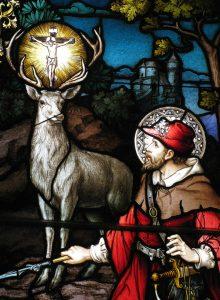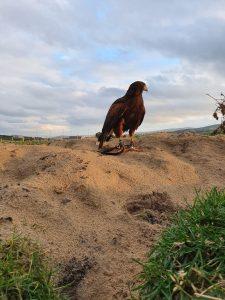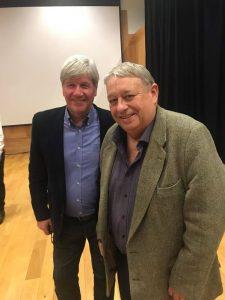Irish Extra December 2020

November saw the celebration of 2 notable days for the country sports fraternity, the first being St Huberts Day on 3rd November & secondly World Falconry Day on 16th November. The eldest son of Bertrans, the Duke of Aquitaine, Hubert was born in 638 AD. A prince of the House of Aquitaine in France, when he was young Hubert enjoyed the “good life” of nobility, and most of all he loved hunting. One Good Friday, when he should have been in church, Hubert galloped off on horseback to hunt a stag. His hounds cornered a large stag. As Hubert approached, suddenly he had a vision of a glowing crucifix appearing over the deer’s head. A voice spoke to him and said: “Hubert, unless thou turnest to the Lord, and leadest a holy life, thou shalt quickly go to hell.” Hubert climbed down off his horse and begged forgiveness. The voice instructed him to seek guidance from Lambert, the Bishop of Maastricht. Not long after seeking out the Bishop, Hubert’s wife died in childbirth. Hubert soon entered the Abbey of Staveleot, became Lambert’s student, and became a priest, giving his belongings to charity and the care of his young son to his brother.
Lambert advised Hubert to make a pilgrimage to Rome in 705 AD. During Hubert’s absence, Lambert was murdered. Hubert was selected by the Pope to succeed his mentor as Bishop. Later Hubert built St. Peter’s Cathedral in Liege, Belgium, on the spot where Lambert had died, and he in turn became the patron of the city.
Hubert applied his passion for hunting to his faith, establishing Christianity in large sections of the Ardennes forest. He preached to many of the hunters and is said to have hunted and kept dogs all his life. Hubert is also said to have been blessed with miraculous powers to heal rabies, aided by a special white and gold silk stole that he said was given to him by the Blessed Virgin Mary. He also had a golden key, which was reputed to be a healing amulet.
Hubert died quietly on May 30, 727 AD with the words “Our father, who art in heaven…” on his lips. In 1744 he was canonized as a saint; the patron saint of hunting, trapping and butchers. While St Hubert celebrations were obviously different this year, the Saint of the hunter & his lasting legacy was not forgotten.
I celebrated World Falconry day with a roast rabbit my old feathered lurcher “Horus” had a caught a week prior. I was very proud of him as it has taken us a while to really get to this stage. A rabbit bolted which he pursued quite hard but missed after a missed strike. He then positioned himself on a telegraph pole and quickly spotted a second bolter coming his way & with impeccable timing, dropped like a stone & with a satisfying thump, bound with a rather large rabbit, I think he was as proud as me!

Falconry, recognised by Unesco as a living Heritage & traditional sport is widely believed to have originated in in Central Asia and the Iranian Plateau and spread via cultural and trade links to other diverse regions including East Asia, North Africa, Europe, and later in the 16th century CE to much of the rest of the world. The earliest solid evidence for falconry, a pottery sherd depicting a bird of prey, comes from Tell Chuera site in modern day Syria, and dates from the third millennium BCE. Whilst the oldest rock art images of falconers are found in the Altai Mountain range which spans parts of Central and East Asia, dating from around 1000 BCE. By the early Middle Ages, falconry had spread considerably and is documented in many parts of the world, including in painted depictions on Chinese tombs from the Tang Period (618 – 907 CE).
The tradition became particularly popular along the Silk Roads amongst people living in the steppe regions of Central Asia. Indeed, the falcon was an important symbolic bird in ancient Mongolia. Along the Silk Roads, falconry, and in particular the practice of exchanging hunting birds as gifts was closely associated with diplomacy and cultural interactions between the various societies along these routes. Another of the ways in which the practice spread was via merchants who often carried knowledge of the practice, as well as the hunting birds themselves, back home with them after encountering falconry in parts of Central Asia and the Arabian Peninsula.
Today falconry remains integrated into communities as part of a social recreational practice and popular means of interacting with nature. Although it was originally predominantly a technique for acquiring food, the practice has evolved over time to become a traditional sport which has acquired many other values and a greater social significance. In particular it has become associated with camaraderie, sharing expressions of freedom, and a connection with nature. Furthermore, along the lengths of the Silk Roads, falconry has inspired a vast swathe of artistic creativity including books, manuscripts, poetry, paintings, and historical buildings. The falcon remains an important cultural symbol in many countries and is often used on postage stamps, coins and on coats of arms.

Passing of a warm-hearted Country Sports Ambassador
I was saddened by the recent death of David Campbell. David, a photographer by trade was a well known country sports enthusiast and I had the pleasure of his warm personality and great knowledge of many subjects as a fellow gun at a few shoots over the years. David shot many covers for Irish country sports publications and was often spotted at the Irish Game Fair with his Italian Spinone & always a warm smile and handshake. He really was a great guy and one I will remember with a smile.

I write every year at this time that I begin the new year with an empty corner on my desk and each week and month my copies of the CMW pile up until I don’t notice them any longer. Suddenly I find myself writing the last column of the year and with the new one I then find myself wrapping up the previous bundle and placing it in the loft with the previous years, and this pile seems to be ever increasing. It has been a particularly strange year, a year I think to reflect on the positive things and be grateful for what we have. I am personally grateful to be able to scribble down my thoughts each month for a magazine that supports the country sports & hunting community through everything and I know this year in particular has been all the more improved with arrival of our magazine each week. I hope and look forward to continuing in 2021 and well beyond would like to extend my sincerest thanks to Tracey and the rest of the team & to every fellow writer, subscriber and reader, may you have a pleasant Christmas with much sport and a fantastic New Year.
Until 2021 – Good Hunting!